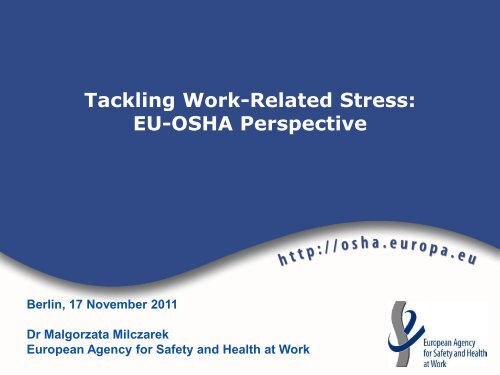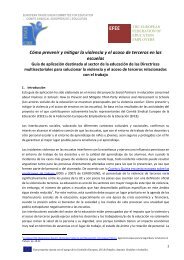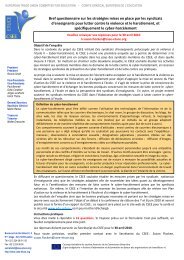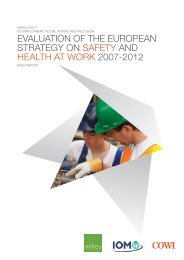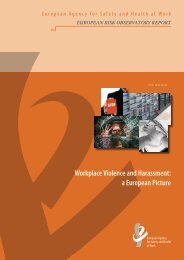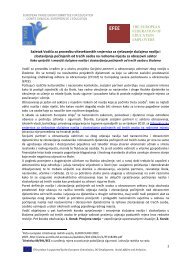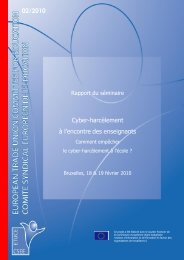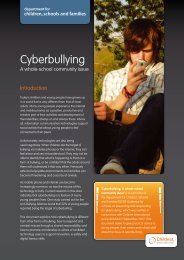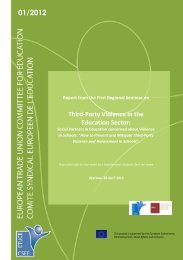Tackling Work-Related Stress: EU-OSHA Perspective - Teachers ...
Tackling Work-Related Stress: EU-OSHA Perspective - Teachers ...
Tackling Work-Related Stress: EU-OSHA Perspective - Teachers ...
Create successful ePaper yourself
Turn your PDF publications into a flip-book with our unique Google optimized e-Paper software.
<strong>Tackling</strong> <strong>Work</strong>-<strong>Related</strong> <strong>Stress</strong>:<br />
<strong>EU</strong>-<strong>OSHA</strong> <strong>Perspective</strong><br />
Berlin, 17 November 2011<br />
Dr Malgorzata Milczarek<br />
European Agency for Safety and Health at <strong>Work</strong>
<strong>EU</strong>-<strong>OSHA</strong><br />
‣ The European Agency for Safety and Health at <strong>Work</strong><br />
was established in 1996 in Bilbao to help improve<br />
working conditions in the European Union<br />
‣ <strong>EU</strong>-<strong>OSHA</strong>:<br />
• identifies emerging risks (research)<br />
• consolidates knowledge (reports)<br />
• stimulates debate (seminars)<br />
• collects and disseminates<br />
good practice information<br />
• organises raising-awareness<br />
campaigns<br />
• develops and disseminates<br />
practical tools
FOCAL<br />
POINTS<br />
<strong>EU</strong> Focal Points<br />
Candidate & Potential<br />
Candidate Countries<br />
EEA/EFTA<br />
Focal Points
<strong>Work</strong>-related stress: facts<br />
‣ <strong>Work</strong>-related stress is one of the biggest<br />
health and safety challenges that we face in<br />
Europe.<br />
‣ <strong>Stress</strong> is the second most reported work-related<br />
health problem. <strong>EU</strong> Labour Force Survey (2007):<br />
• 28% of workers reported that work negatively<br />
affects their mental well-being<br />
• 14% of workers who reported work-related health<br />
problems, experienced stress, depresion,<br />
or anxiety as the main problem<br />
‣ The number of people suffering from<br />
stress-related conditions caused or<br />
made worse by work is likely to increase
<strong>Work</strong>-related stress<br />
‣ <strong>Stress</strong>: definition and causes<br />
• People experience stress when they perceive<br />
that there is an imbalance between the<br />
demands made of them and the resources<br />
they have available to cope with those<br />
demands.<br />
• Although the experience of stress is<br />
psychological, stress also affects people’s<br />
physical health.
‣ Symptoms of work-related stress<br />
• Organisational:<br />
o absenteeism, high staff turnover, poor<br />
time-keeping, disciplinary problems,<br />
harassment, reduced productivity,<br />
accidents, errors, and increased costs<br />
from compensation or health care.
‣ Symptoms of work-related stress<br />
• Individual:<br />
o<br />
o<br />
o<br />
o<br />
Emotional: irritability, anxiety, sleep problems,<br />
depression, hypochondria, alienation, burnout,<br />
relationship problems<br />
Cognitive: difficulty in concentrating,<br />
remembering, learning new things, making<br />
decisions<br />
Behavioural: abuse of drugs, alcohol, and<br />
tobacco<br />
Physiological: back problems, weakened<br />
immunity, peptic ulcers, heart problems,<br />
hypertension.
‣ Consequences of third party violence<br />
‣ At the individual level:<br />
• Physical injuries<br />
• <strong>Stress</strong>, fear, psychosomatic symptoms (headaches),<br />
negative mood, emotional exhaustion, sleeping<br />
problems, anxiety, sleeping problems, depression,<br />
problems with concentration, reduced job satisfaction<br />
‣ At the organisational level:<br />
• High absenteeism, high turnover, insurance costs,<br />
impaired performance
<strong>EU</strong>-<strong>OSHA</strong> research<br />
‣ European Survey of Enterprises on New &<br />
Emerging Risks – Psychosocial Risks (ESENER)<br />
• ESENER Survey asks managers and workers' representatives<br />
about how health and safety risks are managed at their<br />
workplace, with a particular focus on the work-related stress,<br />
violence and harassment.<br />
• Computer-assisted telephone interviews (“CATI”)<br />
• 2 questionnaires<br />
• 31 countries: 36,000 interviews (2009)<br />
• 41 national versions of each questionnaire<br />
• “Enterprises” = both public and private sectors<br />
http://esener.eu
How are psychosocial risks being managed<br />
‣ Main concerns and causes<br />
• Level of concern about stress, violence and<br />
bullying or harassment; what are the principal<br />
risk factors (e.g. time pressure, poor<br />
communication, job insecurity, etc.)<br />
‣ Measures taken<br />
• Ad-hoc or ‘reactive’ measures (e.g. training,<br />
change to work organisation, work area<br />
redesign, confidential support, changes to<br />
working time, conflict resolution)<br />
‣ Procedures in place<br />
• More formal or system based than ‘measures’,<br />
e.g. procedures to deal with stress, with<br />
violence or with bullying or harassment
Level of concern about various health and safety<br />
issues<br />
Accidents<br />
MSDs<br />
WR <strong>Stress</strong><br />
Dangerous<br />
substances<br />
Noise and<br />
vibration<br />
Violence or<br />
threat of<br />
violence<br />
Bullying or<br />
harassment<br />
% establishments<br />
10 0<br />
90<br />
80<br />
70<br />
60<br />
50<br />
40<br />
30<br />
20<br />
10<br />
0<br />
Major concern Some concern No concern DK/ NA<br />
(ESENER, 2009)
Main concerns and causes<br />
Concern regarding work-related stress<br />
% establishments<br />
100%<br />
90%<br />
80%<br />
70%<br />
60%<br />
50%<br />
40%<br />
30%<br />
20%<br />
10%<br />
0%<br />
PT<br />
NO<br />
TR<br />
PL<br />
RO<br />
BG<br />
DE<br />
AT<br />
FR<br />
CY<br />
SI<br />
LU<br />
EL<br />
TOTAL 31<br />
ES<br />
<strong>EU</strong>-27<br />
CH<br />
LV<br />
HR<br />
DK<br />
BE<br />
IE<br />
SK<br />
MT<br />
UK<br />
CZ<br />
HU<br />
EE<br />
NL<br />
SE<br />
FI<br />
LT<br />
IT<br />
Major concern Some concern No concern DK/ NA
Concern regarding violence or threat of violence<br />
% establishments<br />
100%<br />
90%<br />
80%<br />
70%<br />
60%<br />
50%<br />
40%<br />
30%<br />
20%<br />
10%<br />
TR<br />
PT<br />
RO<br />
BG<br />
PL<br />
FR<br />
NO<br />
ES<br />
LV<br />
TOTAL 31<br />
BE<br />
CZ<br />
IE<br />
<strong>EU</strong>-27<br />
CY<br />
UK<br />
CH<br />
DE<br />
LU<br />
HR<br />
EL<br />
AT<br />
DK<br />
SK<br />
LT<br />
SE<br />
FI<br />
MT<br />
NL<br />
IT<br />
HU<br />
SI<br />
EE<br />
0%<br />
Major concern Some concern No concern DK/ NA<br />
(ESENER, 2009)
Concern about work-related stress, harassment, or<br />
violence (ESENER, 2009)<br />
% establishments<br />
Health and social w ork<br />
Education<br />
Public administration and defence; compulsory social<br />
security<br />
Real estate, renting and business activities<br />
Financial intermediation<br />
Other community, social and personal service activities<br />
Mining and quarrying<br />
Transport, storage and communication<br />
<strong>EU</strong>-27<br />
Wholesale and retail trade; repair of motor vehicles,<br />
motorcycles and personal and household goods<br />
Hotels and restaurants<br />
Construction<br />
Electricity, gas and w ater supply<br />
Manufacturing<br />
0 10 20 30 40 50 60 70 80 90 100<br />
Bullying or harassment Violence or threat of violence <strong>Work</strong>-related stress<br />
(ESENER, 2009)
Prevalence of procedures to deal with work-related<br />
stress, harassment, or violence<br />
% establishments, <strong>EU</strong>27<br />
H ealth and so cial wo rk<br />
Educatio n<br />
F inancial intermediatio n<br />
H o tels and restaurants<br />
Other co mmunity, so cial and perso nal<br />
service activities<br />
R eal estate, renting and business activities<br />
P ublic administratio n and defence;<br />
co mpulso ry so cial security<br />
Who lesale and retail trade; repair o f mo to r<br />
vehicles, mo to rcycles and perso nal and<br />
ho useho ld go o ds<br />
T ranspo rt, sto rage and co mmunicatio n<br />
M ining and quarrying and Electricity, gas<br />
and water supply<br />
C o nstructio n<br />
M anufacturing<br />
(ESENER, 2009)<br />
0% 10% 20% 30% 40% 50% 60% 70% 80% 90% 100%<br />
Bullying or harassment <strong>Work</strong>-related violence <strong>Work</strong>-related stress
Concern about various psychosocial risk factors<br />
% establishments<br />
100<br />
90<br />
80<br />
70<br />
60<br />
50<br />
40<br />
30<br />
20<br />
10<br />
0<br />
Time pressure<br />
Having to deal<br />
w ith difficul<br />
customers,<br />
patients, pupils,<br />
etc<br />
Poor<br />
communication<br />
betw een<br />
management<br />
and employees<br />
Job insecurity<br />
Poor cooperation<br />
amongst<br />
colleagues<br />
Long or<br />
irregular<br />
w orking hours<br />
Problems in<br />
supervisor -<br />
employee<br />
relationships<br />
Lack of<br />
employee<br />
control in<br />
organising their<br />
w ork<br />
An unclear<br />
human<br />
resources<br />
policy<br />
Discimination -<br />
for example due<br />
to gender, age<br />
or ethnicity<br />
(ESENER, 2009)
Procedures to deal with psychosocial risks<br />
% establishments<br />
100<br />
90<br />
80<br />
70<br />
60<br />
50<br />
40<br />
30<br />
20<br />
10<br />
0<br />
IE<br />
UK<br />
SE<br />
BE<br />
FI<br />
NO<br />
NL<br />
HR<br />
DK<br />
TOTAL 31<br />
<strong>EU</strong>-27<br />
CH<br />
TR<br />
FR<br />
PL<br />
CZ<br />
DE<br />
ES<br />
RO<br />
LU<br />
MT<br />
LV<br />
SK<br />
SI<br />
IT<br />
BG<br />
CY<br />
PT<br />
AT<br />
LT<br />
EL<br />
HU<br />
EE<br />
Bullying or harassment <strong>Work</strong> related violence <strong>Work</strong> related stress<br />
(ESENER, 2009)
Use of measures to deal with psychosocial risks over the<br />
previous three years<br />
% establishments, <strong>EU</strong>27<br />
100%<br />
90%<br />
80%<br />
70%<br />
60%<br />
50%<br />
40%<br />
30%<br />
20%<br />
10%<br />
0%<br />
10-19 employees 20-49 employees 50-249 employees 250+ employees <strong>EU</strong>-27<br />
Provision of training Changes to the w ay w ork is organised A redesign of the w ork area<br />
Confidential counselling for employees Changes to w orking time arrangements Set-up of a conflict resolution procedure<br />
(ESENER, 2009)
Health and safety issues raised regularly in high level<br />
management meetings<br />
% establishments<br />
100<br />
80<br />
60<br />
40<br />
20<br />
0<br />
SE<br />
UK<br />
NL<br />
NO<br />
IE<br />
DK<br />
SK<br />
BE<br />
FR<br />
RO<br />
<strong>EU</strong>-27<br />
BG<br />
TOTAL 31<br />
FI<br />
CZ<br />
LU<br />
ES<br />
CY<br />
IT<br />
MT<br />
HR<br />
DE<br />
PL<br />
HU<br />
AT<br />
PT<br />
TR<br />
EL<br />
CH<br />
LV<br />
SI<br />
EE<br />
LT<br />
(ESENER, 2009)
Main difficulties in dealing with health and safety and<br />
with psychosocial risks<br />
% establishments, <strong>EU</strong>-27<br />
100%<br />
90%<br />
80%<br />
70%<br />
60%<br />
50%<br />
40%<br />
30%<br />
20%<br />
10%<br />
0%<br />
Lack of<br />
resources such<br />
as time, staff or<br />
money<br />
Lack of<br />
aw areness<br />
Lack of<br />
expertise<br />
Health and safety<br />
Culture w ithin<br />
the<br />
establishment<br />
Sensitivity of the<br />
issue<br />
Psychosocial risks<br />
Lack of technical<br />
support or<br />
guidance<br />
(ESENER, 2009)
Managing psychosocial risks<br />
‣ Employers have an obligation to manage<br />
work-related stress, through the Framework<br />
Directive 89/391/EEC.<br />
‣ Framework agreement on work-related<br />
stress (2004)<br />
‣ Framework agreement on harassment and<br />
violence at work (2007)<br />
• increasing the awareness and understanding of employers, workers<br />
and their representatives of work-related stress, workplace<br />
harassment and violence,<br />
• providing employers, workers and their representatives at all levels<br />
with an action-oriented framework to identify, prevent and manage<br />
problems of work-related stress, harassment and violence at work.
Managing psychosocial risks<br />
‣ The key to manage psychosocial risks and<br />
prevent work-related stress lies with the<br />
organisation and management of work.<br />
‣ Risk assessment for psychosocial risks<br />
involves the same basic principles and<br />
processes as for other workplace hazards<br />
‣ Including workers and their representatives<br />
in the process is crucial to success.
Risk Assessment – the 5 steps<br />
Identify the<br />
hazards<br />
and those at risk<br />
Evaluate and<br />
prioritise<br />
the risk<br />
(who may be<br />
harmed and how)<br />
Monitor and<br />
review the<br />
situation<br />
Decide on<br />
preventive actions<br />
Take action!<br />
‣ Consult the workers – both on the hazards and<br />
risks and on the proposed solutions
Identifying hazards<br />
‣ Psychosocial risks<br />
• Control: Low participation in decision making, lack of<br />
control over work methods<br />
• Organisational culture & function: Poor<br />
communication, lack of definition of, organisational<br />
objectives<br />
• Interpersonal relationships at work: conflicts, lack of<br />
social support<br />
• Role in the organisation: role ambiguity, role conflict<br />
• Career development: career stagnation and<br />
uncertainty, job insecurity<br />
• Home-work interface: conflicting demands of work and<br />
home
Identifying hazards<br />
‣ Psychosocial risks<br />
• Job content: lack of variety, under use of skills, dealing<br />
with difficult clients, patients, students<br />
• <strong>Work</strong>load & work pace: work overload or under load,<br />
machine pacing, time pressure<br />
• <strong>Work</strong> schedule: shift working, night shifts, inflexible<br />
work schedules, unpredictable hours, long or unsociable<br />
hours<br />
• Environment & equipment: inadequate equipment<br />
availability, suitability or maintenance, lack of space, poor<br />
lighting, excessive noise<br />
‣ Organisational and individual symptoms of<br />
stress
<strong>EU</strong>-<strong>OSHA</strong>: publications and practical tools<br />
‣ Factsheets: <strong>Work</strong>-related stress,<br />
Prevention of violence to staff<br />
in the education sector<br />
‣ E-fact 31 - Prevention of work-related stress in the education<br />
sector<br />
‣ Reports: Research on <strong>Work</strong>-related <strong>Stress</strong>; How to Tackle<br />
Psychosocial Issues and Reduce <strong>Work</strong>-related <strong>Stress</strong>.<br />
‣ ESENER: mapping tool (www.esener.eu), printed<br />
publications<br />
‣ OiRA – Online interactive Risk Assessment –<br />
Psychosocial modul
<strong>EU</strong>-<strong>OSHA</strong> European Campaigns<br />
‣ Raising-awareness Campaign 2014 – 2015:<br />
“Practical solutions for psychosocial risks”<br />
• <strong>Work</strong>-related stress, violence, and harassment at work can<br />
be successfully managed<br />
• Promoting tools and methods that have been developed<br />
over the last decade to manage work-related stress,<br />
violence and harassment<br />
• Disseminating good practice examples (at both national &<br />
<strong>EU</strong> level), including tools for workers’ representatives and<br />
line managers
Thank you for your attention!<br />
<strong>EU</strong>-<strong>OSHA</strong>: http://osha.europa.eu<br />
Malgorzata Milczarek:<br />
milczarek@osha.europa.eu


